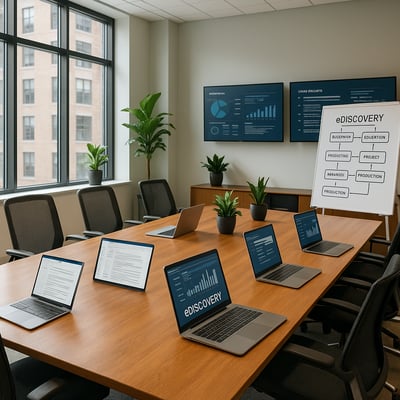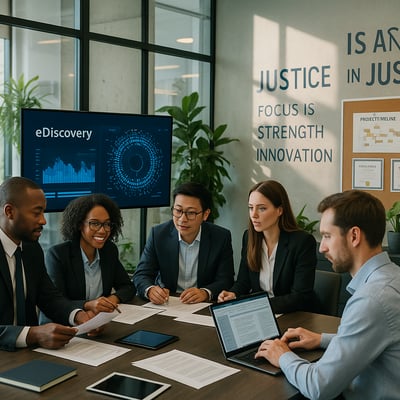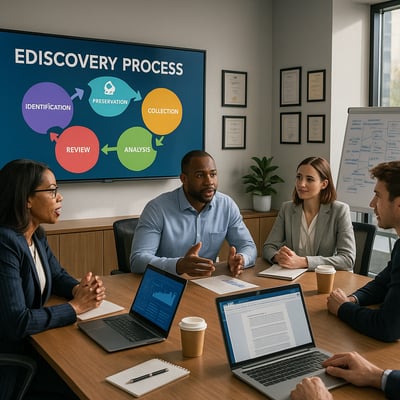" Cut Through the Digital Clutter: Why eDiscovery Is No Longer Optional \n In today’s legal...

Every week, the Array team reviews the latest news and analysis about the evolving field of eDiscovery to bring you the topics and trends you need to know. This week’s post covers the week of June 3-9. Here’s what’s happening.
On his eDiscovery Today blog, Doug Austin elaborated on the debate surrounding modern or hyperlinked attachments that’s picked up steam with recent rulings in the cases of In re StubHub Refund Litigation and In re Insulin Pricing Litigation, in which ESI orders were modified and established to exclude production of hyperlinked documents in emails as if they were attachments.
Taking stock of social media comments about each case, Austin noticed a trend and compiled a list of six myths about hyperlinked attachments. Let’s take a look at two of these myths.
The first myth, which Austin amended in a follow-up post, is “If you can’t discover the linked file from the email, you can’t discover it at all.” If you understand why this myth is false, it’s an important tool to have, especially in the context of these recent decisions. As Austin writes, the email is not the only path to linked files – discovery can be directed to cloud-based archives like Google Vault, OneDrive, and SharePoint.
While most discovery certainly centers around document productions, as this process is usually the most time consuming and expensive portion of discovery, it’s good to remember that discovery includes five components: depositions, interrogatories, requests for production of documents (or permission to inspect), physical and mental examinations, and requests for admission. An interrogatory is a fantastic vehicle to allow a party to perform some due diligence around their opposition’s systems and potential sources of relevant data outside of email. Through this process, a case team may learn what systems are being used and request production of alternative data sources to email, such as cloud-based document repositories, if production of linked attachments proves to be overly difficult or burdensome.
Another myth was “Case law ruling decisions based on burden of discovery will have long-term precedent.” This myth emerged from the fact that the defendants in Insulin cited StubHub in their arguments to the court, and won. But this myth is also false, Austin writes, because discovery tools and burdens of producing hyperlinked attachments as email attachments will evolve over time.
As we wrote last week, in StubHub, after stipulating to a requirement to produce hyperlinked documents as if they were attached to emails, the defense provided good cause as to why it couldn’t comply with the order and moved for relief. In Insulin Pricing Litigation, the defense and plaintiffs couldn’t agree on several ESI issues, including hyperlinks, and defendants successfully argued producing linked documents with any affiliated family group would be technologically infeasible and cause undue burden.
These rulings were tailored based on the ability of a party to produce hyperlinks and the burden of doing so; hopefully as technology improves, future courts will take these changes into account and hold future parties to a different standard of production.
On the ACEDS Blog, Daniel Robinson writes that eDiscovery certified legal professionals “are better positioned to positively influence case outcomes, enhance client satisfaction, and foster significant professional growth.”
At Array, our eDiscovery professionals hold many different certifications and constantly evaluate new technologies, ensuring we can give our clients the best service and outcomes. Our certifications include the Certified eDiscovery Specialist (CEDS) certification, offered by ACEDS, which covers a comprehensive overview of the e-discovery process, including legal hold, data collection, and review. Additionally, our Project Managers and Solutions team members also hold JDs, Relativity certifications, and have been the recipients of awards and honors across various modules of the eDiscovery workflow.
Other recent eDiscovery news and headlines:
With a decade of expertise, Julia excels at optimizing enterprise eDiscovery workflows from start to finish. With a deep understanding of how to seamlessly integrate workflows across various eDiscovery platforms, Julia creates tailored solutions for data identification, legal holds, ESI collections, and productions. By harnessing the power of Technology Assisted Review and Analytics, she delivers efficient, cost-effective results that align with best practices and budgetary constraints. Julia’s exceptional communication and customer service skills have fostered strong, lasting relationships with both clients and Project Management teams, enabling her to effectively problem-solve and drive success across numerous projects.

" Cut Through the Digital Clutter: Why eDiscovery Is No Longer Optional \n In today’s legal...



Every week, the Array team reviews the latest news and analysis about the evolving field of...